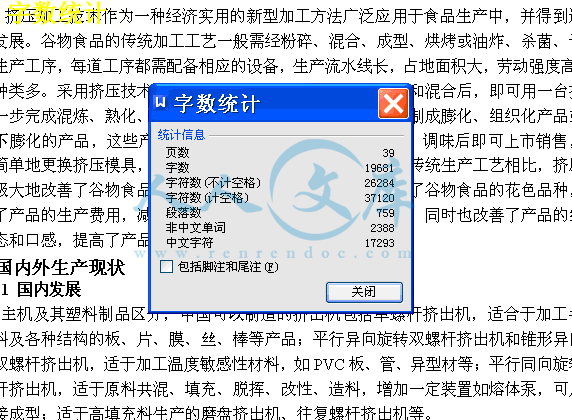摘 要
本文先分析了挤压机的市场需求和生产现状,并初步探讨了挤压机生产食品的工艺可行性;提出了用双螺杆挤压机生产食品的工艺流程。在现有挤压机的基础上,并参考了国内外比较成熟的挤压机设计方法,根据各种食品的特性和生产食品的特殊工艺要求,对挤压机的关键部位进行了相应的设计。本文详细的介绍了挤压机的主要零部件传动箱、传动系统、机筒等的结构设计,并进行了相应的校核计算;对主要传动零部件如传动箱大小齿轮,带轮,从动轴,键等进行了设计和强度校核,并对轴承承载能力进行了校核计算;本文还涉及了挤压机一些辅助元件如加料系统,加热冷却装置,模头的选择要求,并进行了简单的设计。最后,本文介绍了一些关于挤压机的安装,操作,控制和维护等方面的内容。
关键词:传动系统;挤压混炼;反向旋转双螺杆挤压机
Abstract
In this page, the market need of the extrusion press and the condition of the production is analyzed first. And from theoretically, we studied the technique possibility to produce the foods. We expounded the specialty and working elements of the twin-screw extruder and pointed working flow to produce the foods with twin-screw extruder. In the base of the extruders in existence, we referenced the mature means of extruder design in our country and abroad and based the characteristic of foods and the special working craftwork requires, then, we designed the key structure of extruder. In this text, we introduced the structure design of extruder in detail, particular to the major parts: assignment tank, screw, barrel and systems analysis and calculating. To those important transmission parts: the big gear and the small gears in assignment tank, strip wheel, driving spindle, key, we made a design and check the intensity. And we calculate and check the carrying capacity of the bearing particularly. We also refer to the choosing requirements of the accessories: heating and cooling system, die, knife equipment, and made a simple design. In the end of the text, the installing, operation, controlling and repairing of the extruder were also introduced.
Key words: The transmission system;extrusion mixing and shaping;Counter-rotation twin -screw extruder
目 录
摘 要 III
Abstract IV
目 录 V
1 绪论 1
1.1 挤压机技术应用及分析 1
1.2 国内外生产现状 1
1.2.1 国内发展 1
1.2.2 国际上主要有以下方面 1
1.3 挤压机生产食品的可行性分析 2
1.4 挤压技术在口香糖加工中的应用 2
1.4.1 口香糖的市场需求 2
1.4.2 口香糖的加工工艺 2
1.4.3 挤压机生产口香糖的可行性 4
2 食品挤压机挤压设备简介 6
2.1 双螺杆挤压机的工作原理 6
2.1.1 挤压原理 6
2.1.2 挤压加工系统 7
2.2 总体结构设计 7
3 双螺杆挤压机挤压设备设计 8
3.1 传动系统的设计及计算 8
3.1.1 传动系统设计 8
3.1.2 电动机的选用 8
3.1.3 传动比分配 8
3.1.4 主要传动零部件设计计算和校核 9
3.2 辅助零部件设计计算 20
3.2.1 加料系统设计计算 20
3.2.2 加热与冷却系统的设计 22
3.2.3 润滑油的选用 24
4 挤压加工系统的安装、操作与维护 25
4.1挤压加工系统的安装 25
4.1.1 挤压机的安装基础 25
4.1.2 调整挤压机水平 25
4.1.3 机筒的安装 25
4.1.4 螺秆的装拆 25
4.1.5 模头的安装 25
4.2 挤压加工系统的操作 25
4.2.1 挤压机的开车 25
4.2.2 开车操作注意事项 25
4.3 挤压机的维护保养 25
4.3.1 螺杆的保养 25
4.3.2 机筒的保养 25
4.3.3 挤压机其它部分的保养 26
4.4 设计中的几个问题 26
5 总结与展望 27
5.1 总结 27
5.2 展望 27
致 谢 28
参考文献 29
1 绪论
1.1 挤压机技术应用及分析
挤压加工技术作为一种经济实用的新型加工方法广泛应用于食品生产中,并得到迅速的发展。谷物食品的传统加工工艺一般需经粉碎、混合、成型、烘烤或油炸、杀菌、干燥等生产工序,每道工序都需配备相应的设备,生产流水线长,占地面积大,劳动强度高,设备种类多。采用挤压技术来加工谷物食品,在原料经初步粉碎和混合后,即可用一台挤压机一步完成混炼、熟化、破碎、杀菌、预干燥、成型等工艺,制成膨化、组织化产品或制成不膨化的产品,这些产品再经油炸(也可不经油炸)、烘干、调味后即可上市销售,只要简单地更换挤压模具,便可以很方便地改变产品的造型。与传统生产工艺相比,挤压加工极大地改善了谷物食品的加工工艺,缩短了工艺过程,丰富了谷物食品的花色品种,降低了产品的生产费用,减少了占地面积,大大降低了劳动强度,同时也改善了产品的组织状态和口感,提高了产品质量。
1.2 国内外生产现状
1.2.1 国内发展
从主机及其塑料制品区分,中国可以制造的挤出机包括单螺杆挤出机,适合于加工各种材料及各种结构的板、片、膜、丝、棒等产品;平行异向旋转双螺杆挤出机和锥形异向旋转双螺杆挤出机,适于加工温度敏感性材料,如PVC板、管、异型材等;平行同向旋转双螺杆挤出机,适于原料共混、填充、脱挥、改性、造料,增加一定装置如熔体泵,可用于直接成型;适于高填充料生产的磨盘挤出机、往复螺杆挤出机等。
在我国的塑料加工中,几乎一半的塑料都是由挤出成型来完成的。在常规但螺旋挤出机组的性能方面,我国已能生产螺杆直径为12-250的多种规格,门类齐全的挤出机组长径比大多为25—30。在特种挤出机的研究领域,经我国广大科技工作者的努力已经研制出排气挤出机,电磁动态塑化挤出机,串联式磨盘动态挤出机,等多种型号,目前已进入系列的研发阶段。
1.2.2 国际上主要有以下方面
⑴ 新型挤出混炼技术与设备的开发;
⑵ 大口径管材挤出的导向平行双螺杆机出组,钢塑复合管挤出机组和大型双壁波纹管挤出成型机组的开发研究;
⑶ 符合挤出成型和设备的开发研究;
⑷ CAD/CAM/CAE技术在塑料工业中的研究;
⑸ 在线检测机自动控制技术应用。
可以预测,未来挤出成型技术的发展方向是:①高速、高产化;②大型化和精密化;实现挤出成型设备的大型化可以降低生产成本。③模块化和专业化;模块化生产可以缩短新产品的研发周期,争取更大的市场份额;而专业化生产对保证整期质量、降低成本、加速资金周转都非常有利。④智能化和网络化;发达国家的挤出机已普遍采用现代电子和计算机控制技术,这对保证工艺条件的稳定、提高产品的精度都极为有利。⑤高效、多功能化;塑料挤出机的高效主要体现在高产出、低能耗、低制造成本方面。
1.3 挤压机生产食品的可行性分析
本世纪30年代,挤压技术开始应用于食品加工,它具有集输送,混炼,剪切,加热,加压等多种化工单元操作于一体的高温短时加工的特点,因此在食品加工领域的应用范围越来越广泛。除了谷物及植物组织蛋白挤压食品以外,从糖果制造到酪蛋白生产,从固体脂肪到风味成分的开发,及至饲料宠物食品加工制造都用到食品挤压机。
挤压加工概括的说是将食品物料置于挤压机的高压和适当的温度的状态下,然后突然释放到常压,使胶基和各种调味料、香料达到充分渗透、混合和输出的过程。所以用蒸煮挤压法生产可以取得更好的混合效果,原料利用率高,营养损失小,生产出的食品的口感,香味的持久力都比传统的加工方法好。
总的来说,用挤压法生产是现今的发展趋势,并且,传统的加工方法很快也会被挤压法所取代。








 川公网安备: 51019002004831号
川公网安备: 51019002004831号